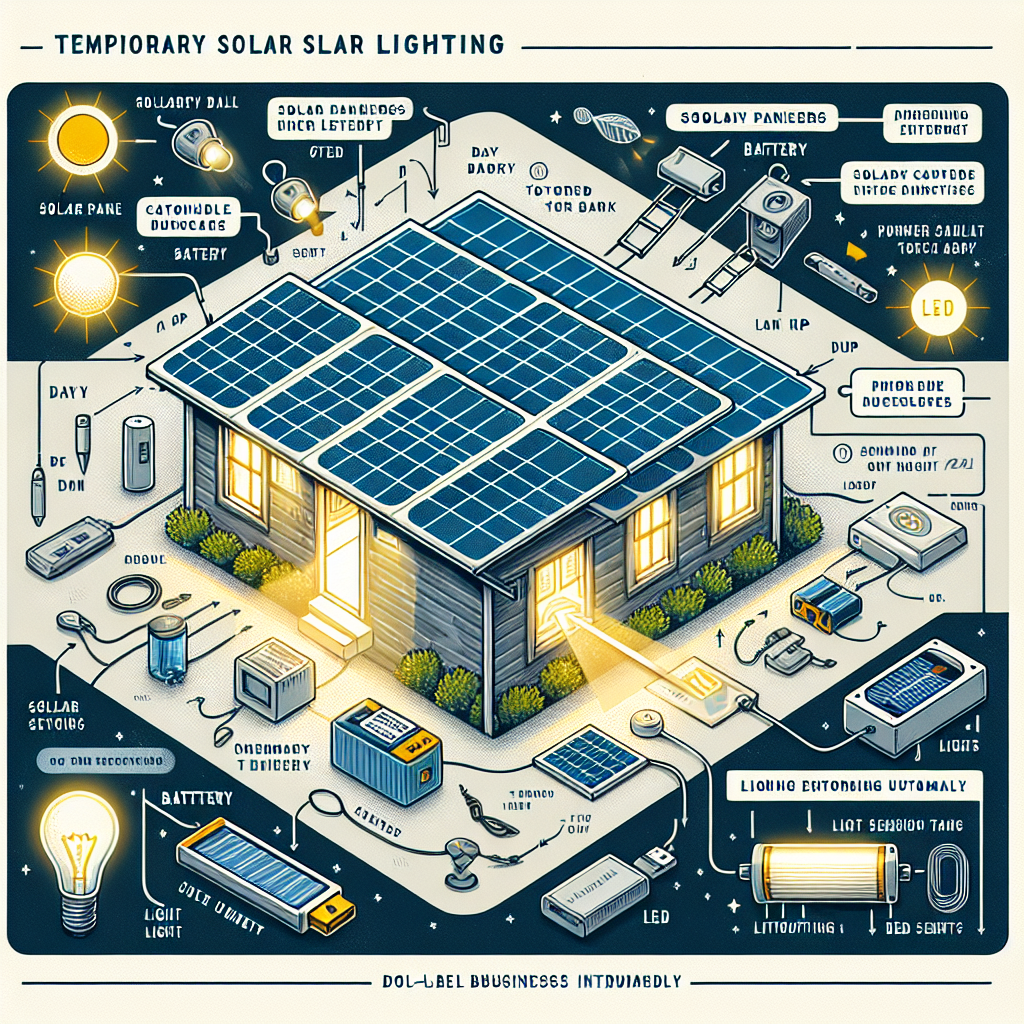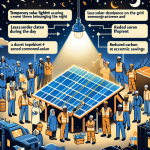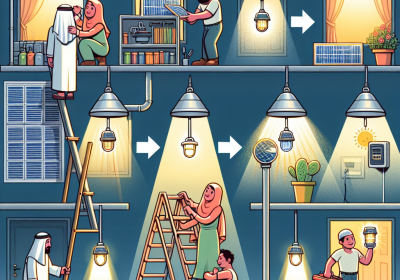Introduction to Temporary Solar Lighting
Table of Contents
Temporary solar lighting is an innovative and sustainable solution designed to provide illumination in areas where traditional electrical infrastructure is unavailable or impractical. Utilizing photovoltaic technology, these systems convert sunlight into electrical energy, which is then stored in batteries for use during nighttime or low-light conditions. Ideal for construction sites, outdoor events, emergency response situations, and remote locations, temporary solar lighting offers a versatile and eco-friendly alternative to conventional lighting methods. By harnessing renewable energy, these systems not only reduce carbon footprints but also offer cost savings and ease of deployment, making them an increasingly popular choice for a variety of applications.
Benefits Of Temporary Solar Lighting For Events And Construction Sites
Temporary solar lighting has emerged as a versatile and sustainable solution for various applications, particularly in events and construction sites. The benefits of utilizing temporary solar lighting in these contexts are manifold, ranging from environmental advantages to economic savings and enhanced safety. As the world increasingly shifts towards renewable energy sources, understanding the specific advantages of temporary solar lighting becomes essential for event organizers and construction managers alike.
One of the primary benefits of temporary solar lighting is its environmental impact. Traditional lighting solutions often rely on fossil fuels, which contribute to greenhouse gas emissions and environmental degradation. In contrast, solar lighting harnesses energy from the sun, a renewable and inexhaustible resource. By reducing reliance on non-renewable energy sources, temporary solar lighting significantly lowers the carbon footprint of events and construction projects. This not only aligns with global sustainability goals but also enhances the reputation of organizations committed to eco-friendly practices.
In addition to its environmental benefits, temporary solar lighting offers substantial economic advantages. The initial investment in solar lighting equipment may be higher than conventional lighting systems; however, the long-term savings are considerable. Solar lighting systems eliminate the need for fuel and reduce electricity costs, as they operate independently of the grid. Furthermore, maintenance costs are generally lower, given the durability and longevity of solar panels and LED lights. Over time, these savings can offset the initial expenditure, making solar lighting a cost-effective choice for temporary applications.
Safety is another critical aspect where temporary solar lighting excels. Construction sites and event venues often require reliable and consistent lighting to ensure the safety of workers and attendees. Solar lighting systems are designed to provide uninterrupted illumination, even in remote or off-grid locations. Many solar lighting units come equipped with battery storage, allowing them to function during nighttime or cloudy conditions. This reliability is crucial in preventing accidents and ensuring smooth operations, particularly in high-risk environments such as construction sites.
Moreover, the ease of installation and portability of temporary solar lighting systems make them highly adaptable to various settings. Unlike traditional lighting, which may require extensive wiring and infrastructure, solar lighting units can be quickly deployed and repositioned as needed. This flexibility is particularly beneficial for events that require rapid setup and teardown or construction projects that progress through different phases. The ability to move lighting units without significant effort or cost enhances operational efficiency and reduces downtime.
Temporary solar lighting also contributes to noise reduction, an often-overlooked benefit. Conventional lighting systems, especially those powered by generators, can produce significant noise pollution, which may be disruptive in certain environments. Solar lighting systems operate silently, creating a more pleasant atmosphere for event attendees and reducing auditory distractions for construction workers. This quiet operation is especially advantageous in residential areas or locations where noise regulations are stringent.
Furthermore, the aesthetic appeal of solar lighting should not be underestimated. Modern solar lighting units are designed with sleek and contemporary aesthetics, making them suitable for a wide range of events, from corporate gatherings to outdoor festivals. The clean and unobtrusive design of solar lights can enhance the overall ambiance of an event, contributing to a positive experience for attendees.
In conclusion, the benefits of temporary solar lighting for events and construction sites are extensive and multifaceted. From environmental sustainability and economic savings to enhanced safety and operational flexibility, solar lighting presents a compelling alternative to traditional lighting solutions. As technology continues to advance and the demand for renewable energy grows, the adoption of temporary solar lighting is likely to increase, offering a brighter and more sustainable future for various temporary applications.
How To Choose The Right Temporary Solar Lighting Solution

When selecting the appropriate temporary solar lighting solution, it is essential to consider several factors to ensure that the chosen system meets your specific needs. Temporary solar lighting has become increasingly popular due to its sustainability, ease of installation, and cost-effectiveness. However, the variety of options available can make the decision-making process somewhat daunting. By carefully evaluating your requirements and understanding the key features of different solar lighting systems, you can make an informed choice that will provide reliable and efficient illumination.
First and foremost, it is crucial to assess the intended application of the temporary solar lighting. Whether you need lighting for a construction site, an outdoor event, or an emergency situation, the purpose will significantly influence the type of system you should select. For instance, construction sites may require robust and high-intensity lighting to ensure safety and productivity, whereas an outdoor event might benefit from aesthetically pleasing and ambient lighting. Understanding the specific context in which the lighting will be used will help narrow down the options.
Another important consideration is the duration for which the temporary solar lighting will be needed. Some projects or events may only require lighting for a few days, while others might need it for several months. The duration will impact the type of solar panels, battery capacity, and overall durability of the system. For short-term use, a more basic and cost-effective solution may suffice. In contrast, long-term applications will benefit from higher-quality components that can withstand extended periods of use and varying weather conditions.
The geographical location and environmental conditions of the site also play a significant role in choosing the right temporary solar lighting solution. Solar panels rely on sunlight to generate power, so it is essential to consider the average sunlight hours and weather patterns in your area. In regions with limited sunlight or frequent overcast conditions, it may be necessary to opt for larger solar panels or systems with higher battery storage capacity to ensure consistent performance. Additionally, the system should be weather-resistant and capable of withstanding harsh conditions such as rain, wind, and extreme temperatures.
Energy efficiency is another critical factor to consider when selecting temporary solar lighting. Modern solar lighting systems often come equipped with energy-efficient LED bulbs, which provide bright illumination while consuming minimal power. This not only extends the battery life but also reduces the overall energy consumption of the system. Furthermore, some advanced systems feature motion sensors or timers that can automatically adjust the lighting based on activity levels or specific time intervals, further enhancing energy efficiency.
Ease of installation and portability are also important aspects to evaluate. Temporary solar lighting solutions should be easy to set up and dismantle, allowing for quick deployment and relocation as needed. Lightweight and compact designs are particularly advantageous for applications that require frequent movement or transportation. Additionally, systems with adjustable mounting options and flexible configurations can provide greater versatility and adaptability to different site conditions.
Lastly, it is essential to consider the cost and budget constraints when choosing a temporary solar lighting solution. While it may be tempting to opt for the cheapest option available, it is important to balance cost with quality and performance. Investing in a reliable and durable system may incur higher upfront costs but can result in long-term savings by reducing maintenance and replacement expenses.
In conclusion, selecting the right temporary solar lighting solution involves a careful evaluation of the intended application, duration of use, geographical location, energy efficiency, ease of installation, and budget. By considering these factors and understanding the specific requirements of your project or event, you can make an informed decision that ensures reliable, efficient, and sustainable illumination.
Installation And Maintenance Tips For Temporary Solar Lighting Systems
Temporary solar lighting systems offer a versatile and eco-friendly solution for various lighting needs, from construction sites to outdoor events. Understanding the installation and maintenance of these systems is crucial for ensuring their optimal performance and longevity. This article provides essential tips for both installing and maintaining temporary solar lighting systems, ensuring that users can maximize their benefits.
To begin with, the installation of temporary solar lighting systems requires careful planning and consideration of several factors. One of the primary considerations is the location. It is imperative to choose a site that receives ample sunlight throughout the day, as the efficiency of solar panels directly depends on the amount of sunlight they can capture. Avoiding shaded areas and obstructions such as trees or buildings is essential to ensure maximum exposure to sunlight. Additionally, the angle at which the solar panels are installed plays a significant role in their efficiency. Ideally, the panels should be tilted at an angle that corresponds to the latitude of the location to capture the maximum amount of solar energy.
Furthermore, the stability of the installation is another critical aspect. Temporary solar lighting systems often need to withstand various weather conditions, including wind and rain. Therefore, securing the solar panels and lighting fixtures firmly is essential to prevent any damage or displacement. Using sturdy mounting brackets and ensuring that all components are tightly fastened can help achieve this stability. Moreover, it is advisable to conduct a thorough inspection of the installation site to identify any potential hazards that could affect the system’s performance.
Transitioning to the maintenance of temporary solar lighting systems, regular upkeep is vital to ensure their continued efficiency and functionality. One of the most important maintenance tasks is cleaning the solar panels. Dust, dirt, and debris can accumulate on the surface of the panels, significantly reducing their ability to absorb sunlight. Cleaning the panels with a soft cloth and mild detergent periodically can help maintain their efficiency. It is also essential to inspect the panels for any signs of damage, such as cracks or scratches, and address any issues promptly.
In addition to cleaning, monitoring the battery health is crucial for the optimal performance of temporary solar lighting systems. The batteries store the energy generated by the solar panels and power the lighting fixtures. Over time, batteries can degrade and lose their capacity to hold a charge. Regularly checking the battery levels and replacing them when necessary can prevent any interruptions in the lighting system’s operation. It is also beneficial to use high-quality batteries that are designed for solar applications, as they tend to have a longer lifespan and better performance.
Moreover, inspecting the wiring and connections is another essential maintenance task. Loose or corroded connections can lead to power loss and affect the overall performance of the system. Ensuring that all connections are secure and free from corrosion can help maintain the system’s efficiency. Additionally, it is advisable to check the lighting fixtures for any signs of wear and tear and replace any damaged components promptly.
In conclusion, the installation and maintenance of temporary solar lighting systems require careful attention to detail and regular upkeep. By selecting an optimal location, ensuring stable installation, and performing routine maintenance tasks such as cleaning the panels, monitoring battery health, and inspecting connections, users can ensure the efficient and reliable operation of their temporary solar lighting systems. These practices not only enhance the performance of the systems but also contribute to their longevity, making them a sustainable and cost-effective lighting solution.
Read more about Temporary Solar Lighting
- Advantages of Temporary Solar Lighting
- Temporary Solar Lighting for Events and Festivals
- Temporary Solar Lighting for Construction Sites
- Temporary Solar Lighting for Outdoor Recreation
- Temporary Solar Lighting for Disaster Relief
- Temporary Solar Lighting for Parking Lots and Garages
- Temporary Solar Lighting for Road and Highway Construction
- Temporary Solar Lighting for Military and Security Operations
- Choosing, Installing, and Maintaining Temporary Solar Lighting









